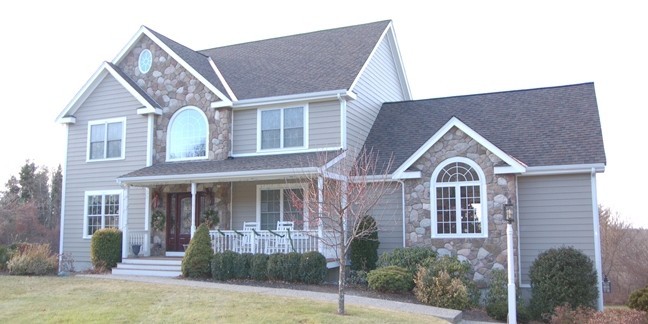
Replacing a home’s siding may not be at the top of most homeowner’s to-do lists. In fact, unless there is a specific and urgent problem with a home’s siding, replacing the siding may not be on the homeowner’s radar at all.
But perhaps it should be.
After all, siding does wear out. It cracks. It breaks. It gets old. Eventually it begins to leak; and when that happens it may already be too late to prevent other major (and potentially expensive) repairs.
But how does a homeowner know when a home needs new siding? What are some of the signs that the homeowner should look for, signs which signal that a home’s siding should be replaced before major damage occurs?
Luckily there are specific things the homeowner should look for in determining whether a home’s siding needs replacement. Here are ten sure-fire signs that a home’s siding needs attention before potentially catastrophic damage takes place.
1 – The Home Needs Frequent Painting
If a home needs frequent painting, say once every five or six years, that is a good sign that something is wrong with the current siding. Good home siding should keep its shape and keep its color for at least 8-10 years, if not longer. Siding that is chipping, pealing, or cracking is an indication that there is a fundamental problem and that the siding needs replacement.
2 – High Heating and Cooling Bills
When a home’s heating or cooling costs go through the roof (so to speak), that can be a sure sign that a home is in need of new siding. Naturally it is important to rule out a bad or leaking roof or lack of attic insulation as the culprit, but heating or cooling costs that are not in line with those of neighbors with similar structures is an indication that something is seriously flawed with a home’s exterior wall insulation.
Poorly performing siding and low grade wall insulation can be a prime cause for excess heating and cooling bills. If a visual inspection of the siding (as well as the seams where it meets the roof) indicates that heating or cooling could be escaping through the siding, then little more needs to be said.
3 – Rotting or Warping
Take some time to do a thorough visual inspection of a home’s siding. Take a relatively sharp object, such as a screwdriver, along on the inspection. Look specifically for warped siding or for rotting boards or other damage to siding material. Poke under any siding that has warped to discover how solid the under layer is. If the layer under a home’s siding has begun to rot or become soft, that is a sure sign that the home’s siding is due for immediate replacement.
4 – Cracked or Loose Siding
If only one or two boards are cracked or have come loose after a storm, this may not be cause for great alarm. It may be possible for a homeowner to remove one or two bad pieces of siding and replace them. Always be sure to check any layers underneath broken or cracked siding to make certain that there has not been additional, and possibly extensive, damage that will need to be repaired.
If large sections of the siding show signs of cracking, or if large numbers of siding pieces are loose, this can indicate severe problems that may require professional services.
In any event, cracked, broken, or loose pieces of siding must be removed and replaced. Otherwise, water may seep behind those pieces of siding and potentially cause severe (and expensive) problems down the line.
5 – Peeling Paint or Loose Wallpaper Inside the  Home
Home
It may not be immediately obvious to all homeowners, but peeling paint or wallpaper that is pulling away from a wall inside of a home can be symptomatic of faulty siding. Bad siding allows moisture to seep its way underneath the siding where it can percolate through wallboard and eventually cause significant damage to the interior walls of a home.
6 – Fungus, Mold, or Mildew
Any type of growth such as fungus, mold, or mildew on a home’s siding, especially at or near seams in the siding, may indicate that water is penetrating it and being held inside the wall, where it is slowly released once again, causing unwanted growth. While not all signs of fungus, mold, or mildew on siding is a cause for alarm, such growth should be cause to investigate further.
7 – Severely Faded Siding
Why should color fading be a cause for concern over a home’s siding? Because nothing lasts forever, and that includes siding. All siding has a life expectancy. Most siding is formulated to hold its color for only as long as the rating of the siding itself. If siding is so old that the color has faded, then that should tell the homeowner that the effective waterproofing of the siding may have also run its course. Faded color may not prove that a siding is no longer viable, but it is a good indication to watch for.
8 – Bubbles in the Siding
One almost certain sign that a home needs new siding is the presence of bubbles just under the surface of the siding. Bubbles are an almost certain indication that water has become trapped. Any indication of water trapped on or under the siding is an immediate red flag. The one thing that siding is meant to do is to keep moisture away from the walls under the siding.
9 – Holes in the Siding
Even small holes in a home’s siding can be a major cause for concern. Generally speaking, holes in siding are caused by insects. If insects have gotten into or through the siding, they can not only cause trouble on their own, but the holes they make also allow rain and snow to get into and, eventually, underneath the siding—and that can mark the beginning of some very costly repair work.
10 – Dry Rot
Tapping on siding with the handle of a screwdriver can reveal dry rot problems before they become noticeable to the naked eye. Dry rot begins below the surface of the siding and eats away the main body of the siding, basically leaving just the top layer of the siding intact. It is possible for the siding to look quite good even when the bulk of the material has rotted away.
Tapping on the surface of the siding with the handle of a screwdriver will reveal weak spots of dry rot, and pieces of siding which suffer from dry rot must be removed immediately and replaced. Extensive dry rot will require the entire home to be re-sided.
There are many reasons a homeowner might want to install new siding on a house.
Protecting a home from potential damage from rain, wind, snow, or insects by replacing old or worn siding is just one reason.
Another reason may be aesthetics. Most homeowners want their home to look its best, and new siding greatly enhances a home’s curb appeal when it comes time to sell.
At the end, one word of caution: replacing siding may look simple, but the truth is, it’s not. Cutting and fitting siding so that it is waterproof and windproof takes a certain amount of experience. Homeowners who are not experienced at replacing siding may be better off hiring professionals to do the job.
Blog by Siding Magazine http://sidingmagazine.com/do-it-yourself/top-10-signs-you-need-to-replace-your-homes-siding/
